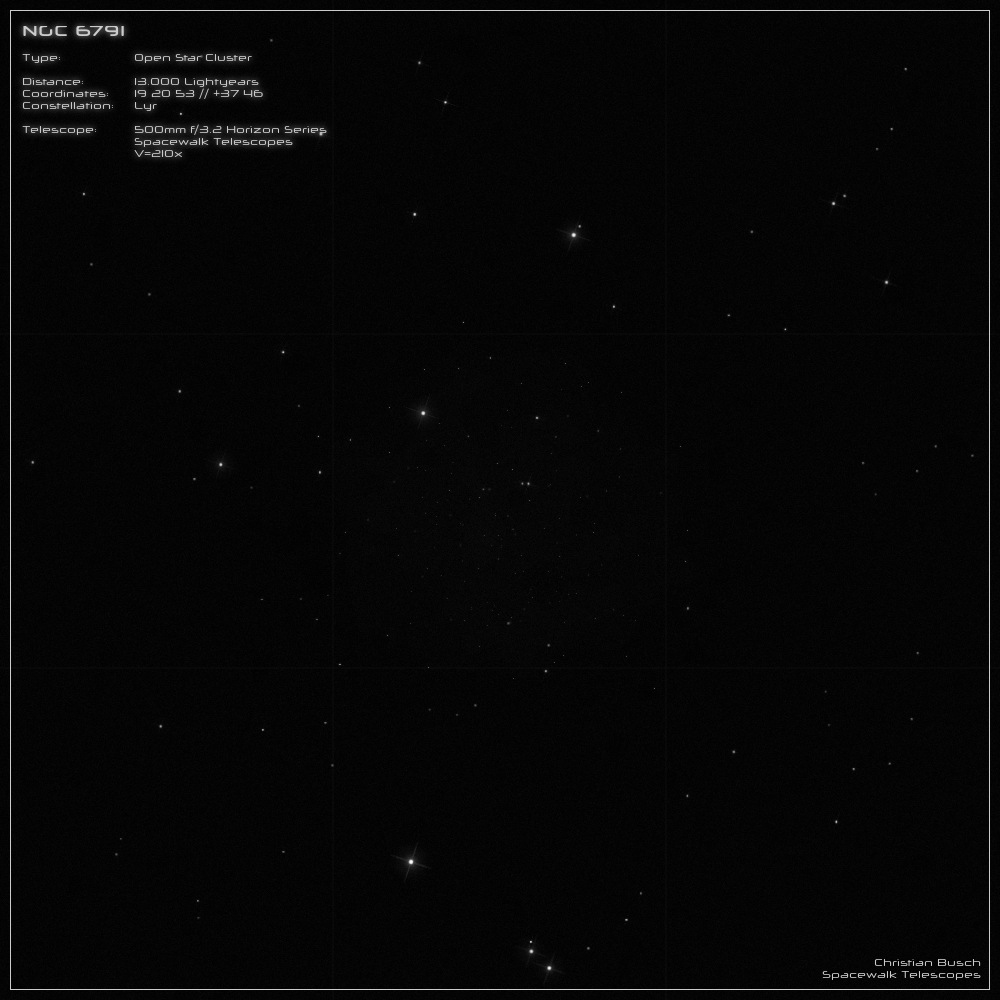NGC 6791, Open Star Cluster
The open star cluster NGC 6791 is one of the few brighter DeepSky objects in the constellation Lyra. It is about 13,000 light-years away from us
and therefore one of the most distant clusters visible in a medium amateur telescope. It was discovered in 1853 by the German astronomer F. Winnecke.
But NGC 6791 is also a superlative star cluster. It contains up to 10,000 stars - that's up to 10x more stars than a cluster normally has. Among them
are many "white dwarfs", the burned out cores of formerly bright stars. The diameter of this stellar sphere can be determined with an assumed apparent
size of the inner dense region of 7' (arcminutes) to about 30 light-years.
The age of NGC 6791 holds a mystery. Observations with the Hubble Space Telescope found three populations of stars - each population with a different
age in the range of 4-8 billion years. This shouldn't really be the case, since the stars in a cluster are usually formed from the same gas cloud and should
therefore be the same age. After one could explain the youngest star generation with the help of its double star nature, now only 2 star populations are
to be reconciled. One may be curious what research will find out here in the next years.
Although the cluster is one of the largest of its kind, it is not easy to observe due to its large distance. This is mainly due to its low surface brightness.
When the sky is brightened, NGC 6791 "drowns" in the sky background and becomes invisible. In addition, the many member stars are very faint, so
high magnification is needed to see them. However, too high a magnification for objects with a low surface brightness is also problematic, because it
too causes the object to drown in the sky background. So in choosing the right magnification, you have to do a little trial and error until you find the
optimum.
----------------------------------------------------------------------------------------------------------------------------------------------
NGC 6791 appears as a brighter, roundish brightening in my 20" f/3 Dobsonian at low magnification. With indirect vision this is quite easy to see at 120x.
One also gets the impression that the gentle glow of the stellar sphere is not quite uniform, but appears mottled - the brightness is not uniform, but exhibits
an irregular structure of brighter and darker spots. Single stars flash out only from time to time.
The view becomes much more interesting if you increase the magnification to 200x to 270x. Then the background glow is not so visible anymore, but a lot
of very faint single stars flash out of the dark sky - the cluster looks like glittering star dust. Altogether there are estimated 60-70 single stars visible, all of
them more or less the same brightness. Only a few are much brighter than the rest. In addition, many of the stars form small clumps of stars. The background
appears grainy. So with a little more aperture a lot more single stars would be visible here.
All in all NGC 6791 is a very exciting object for larger telescopes with more than 16" aperture, with which you can experience the star richness directly
at the eyepiece. But you should bring along a little patience.

